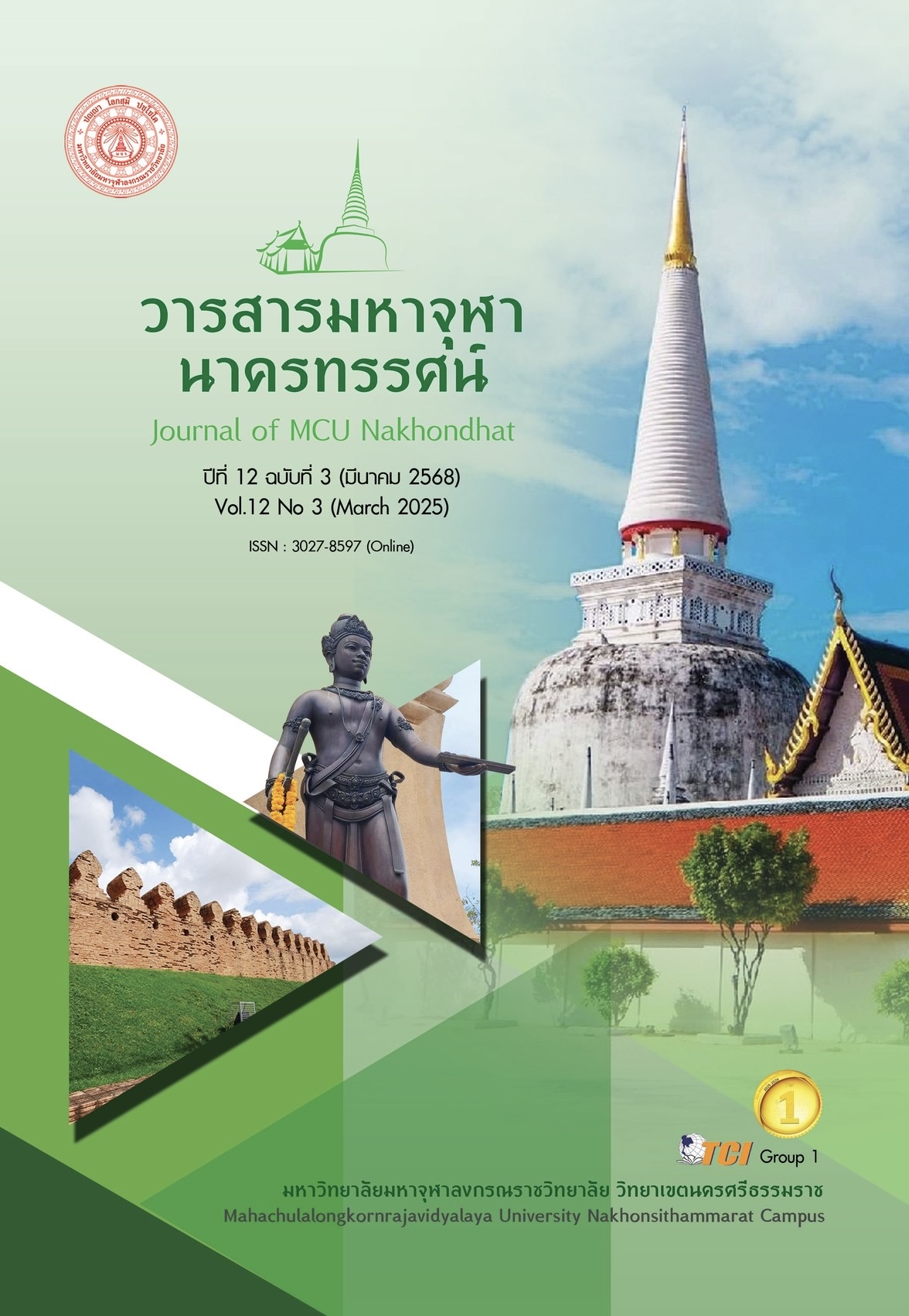PROBLEMS, NEEDS, AND STRATEGIES FOR ENHANCING SPEAKING SKILLS FOR COMMUNICATION IN STUDENTS WITH SPECIAL NEEDS IN INCLUSIVE EDUCATION SETTINGS UNDER THE SECONDARY EDUCATIONAL SERVICE AREA OFFECE, BANGKOK
Main Article Content
Abstract
This study aimed to examine the problems, needs, and strategies for enhancing speaking skills for communication among students with special needs in inclusive schools. A qualitative research approach was employed. Data were collected through interviews with school administrators, special education teachers, and parents of students with special needs from nine inclusive schools, selected through purposive sampling. The research instrument was a semi-structured interview, designed for in-depth discussions. Content analysis was used for data interpretation. The findings revealed that: 1) Problems: Schools currently do not prioritize the development of speaking skills for students with special needs, as the focus remains on academic subjects rather than practical communication skills. Special education teachers are often assigned to teach other subjects to meet required teaching loads. Additionally, students face communication difficulties due to a limited vocabulary. 2) Needs: School administrators should establish policies that support the development of speaking skills, oversee their implementation, and monitor outcomes. Teachers should expand students' essential vocabulary and provide structured training in constructing correct sentences. 3) Strategies for Enhancing Speaking Skills: Schools should incorporate dedicated courses or instructional hours focused on essential communication skills for daily life, such as expressing emotions and refusing requests appropriately. Furthermore, school administrators should encourage teachers to adopt a more inclusive mindset, fostering an environment that acknowledges and respects students diversity.
Article Details

This work is licensed under a Creative Commons Attribution-NonCommercial-NoDerivatives 4.0 International License.
References
กระทรวงศึกษาธิการ. (2551). ตัวชี้วัดและสาระการเรียนรู้แกนกลาง กลุ่มสาระการเรียนรู้ภาษาไทยตามหลักสูตรแกนกลางการศึกษาขั้นพื้นฐาน พุทธศักราช 2551. กรุงเทพมหานคร: ชุมชนสหกรณ์การเกษตรแห่งประเทศไทย จำกัด.
คณาจารย์มหาวิทยาลัยมหาจุฬาลงกรณราชวิทยาลัย. (2551). ภาษากับการสื่อสาร: Language and Communication. กรุงเทพมหานคร: มหาวิทยาลัยมหาจุฬาลงกรณราชวิทยาลัย.
จอมขวัญ สุทธินนท์. (2564). ทักษะการสื่อสาร (Communication Skills). กรุงเทพมหานคร: โอ. เอส. พริ้นติ้ง เฮ้าส์.
ทวีศักดิ์ สิริรัตน์เรขา. (2561). คู่มือการดูแลสุขภาพจิตเด็ก กลุ่มปัญหาการเรียน. (พิมพ์ครั้งที่ 2). กรุงเทพมหานคร: พรอสเพอรัสพลัส.
ทวีศักดิ์ สิริรัตน์เรขา. (2565). ความบกพร่องทางสติปัญญา. เรียกใช้เมื่อ 14 กันยายน 2565 จาก https://www.happyhomeclinic.com/sp05-intellectual-disability.html
พิชิต ฤทธิ์จรูญ. (2561). เทคนิคการวิจัยเพื่อพัฒนาการเรียนรู้. (พิมพ์ครั้งที่ 2). กรุงเทพมหานคร: สำนักพิมพ์แห่งจุฬาลงกรณ์มหาวิทยาลัย.
เรณู สุขเจริญ. (2558). การสื่อสารเพื่อการเรียนรู้ของเด็กพิเศษที่เรียนร่วมในชั้นเรียนเด็กปกติระดับอนุบาล 3 โรงเรียนอนันตา. ใน วิทยานิพนธ์นิเทศศาสตร์มหาบัณฑิต สาขาวิชานิเทศศาสตร์. มหาวิทยาลัยสุโขทัย ธรรมาธิราช.
Beukelman, D. & Mirenda, P. (2013). Augmentative and Alternative Communication: Supporting Children & Adults with Complex Communication Needs. (4th ed.). Baltimore: Paul H: Brookes Publishing.
Cheesman, A. & Read, J. (2023). Prospective pathways from affect to drug outcomes: Refusal self-efficacy in the context of peer influences. Substance Use & Misuse, 58(12), 1587-1597.
Gernsbacher, M. et al. (2016). Language and speech in autism. Annual review of linguistics, 2(1), 413-425.
Gross, J. J. (2022). Emotion regulation: Affective, cognitive, and social consequences. Psychophysiology, 39(3), 281-291.
Nurul, H. et at. (2017). Emotional intelligence (self-awareness, self-management, social awareness and relationship management) and leadership behavior (transformational and transactional) among school educator leaders. International Journal of Educational Studies, 4(2), 37-47.
Ratcliff, A. (1999). Rationale for Preservice Training in AAC. Perspectives on Augmentative and Alternative Communication, 8(1), 3-6.
Romski, M. & Sevcik, R. (1988). Augmentative and alternative communication systems: Considerations for individuals with severe intellectual disabilities. Augmentative and Alternative Communication, 4(2), 83-93.
Salovey, P. & Grewal, D. (2005). The science of emotional intelligence. Current directions in psychological science, 14(6), 281-285.
Senouci, M. et al. (2021). Autism Spectrum as a Communication Disorder: A Case Study. African Educational Research Journal, 9(3), 687-695.
Shady, K. et at. (2024). Barriers and facilitators to healthcare access in adults with intellectual and developmental disorders and communication difficulties: an integrative review. Review Journal of Autism and Developmental Disorders, 11(1), 39-51.
Wallace, S. et al. (2008). An investigation of basic facial expression recognition in autism spectrum disorders. Cognition and Emotion, 22(7), 1353-1380.
Winter, S. (2020). Special Education: From disability to exceptionality. In Quality Education. Cham: Springer International Publishing.

